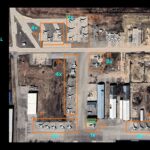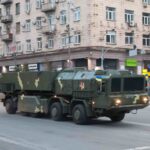During the latest military exercise(“Great Prophet” 15), the Iranian Revolutionary Guards Corps – Aerospace Forces (IRGC-AF) demonstrated how Iran would attack U.S. military bases and warships in the region. Great Prophet 15 (GP15) was Iran’s third drill in almost two weeks – at a time of rising tensions due to the U.S. President Donald Trump’s departure from the White House.
- GP15 is part of a series of annual wargames organized by the IRGC to test new capabilities and tactics. Initiated on 15 January, this year’s exercise featured two stages during which the IRGC-AF simulated a combined drone and missile attack on enemy “U.S.” air defenses, bases, and warships in the Middle East.
- The IRGC-AF successfully test-fired some of its newest and most sophisticated unmanned aerial vehicles (UAVs) and ballistic missiles (B.M.s), including a long-range anti-ship variant that could theoretically target U.S. aircraft carriers.
- The IRGC-AF exercise had three main objectives: To respond to the tensions with the United States, reinforce Iran’s strategic deterrent, and test new ballistic missile technologies.
IRGC-AF “Great Prophet 15” exercise in Garmsar Missile Test Range (Semnan province, Iran) captured on Sentinel-2 imagery:
-Activity hinted on 12 Jan. imagery (before exercise)
-Missile launch burn marks visible on 17 Jan (after).Full analysis 2night @ https://t.co/tbLm0AevBZ pic.twitter.com/zA2KFuMIBm
— T-Intelligence (@T_intell) January 20, 2021
STAGE ONE: AIR DEFENSE ATTACK
(1)In the first phase of GP15, the IRGC-AF simulated a drone swarm attack on enemy radar sites and air defenses. Footage released by Iranian media showcased the following UAVs:
- Shahed 161 combat reconnaissance drone (at least four) flying in formation. One of the many drone variants that the IRGC-AF developed based on the U.S. RQ-170 captured in 2011.

Shahed 161 during GP15
- Shahed 129 medium altitude long-endurance (MALE) drone. At least one was shown taking off, armed with Sadid-345 glide bombs, and then airborne. Similar with the Israeli Hermes 450 and American MQ-1 Predator, the Shahed 129 is one of Iran’s most seasoned UAV. The IRGC-AF operated the Shahed 129 extensively in the Syrian Civil War, and it continues to support it with upgraded ordnance and sensors.

Shahed 129 with Sadid-345 bombs participates in GP15
- Unidentified loitering munition (aka “suicide drones”) neutralizing target buildings and a mobile surface-to-air missile (SAM) system.

A rare sighting: the IRGC’s coy suicide drone makes a cameo at GP15, destroying a variety of targets.
- This unidentified model is similar to the suicide drone Saudi Arabia recovered after the Iranian attack on petrochemical facilities in Abqaiq-Khurais and Afif in 2019. Unable to identify the drone, the Saudis have labeled it “Delta Wave UAV.” Experts have pointed out that Delta Wave might be an evolution of the Toofan-2 suicide drone that Iran unveiled in 2015.

Comparison between the suicide drone from GP15 and the airframe wreckage from Abqaiq-Khurais and Afif, Saudi Arabia (2019)
(2) The use of drones and specifically “suicide drones” for S/DEAD roles (suppression/destruction of enemy air defenses) is a logical tactic for Iran. Due to their stealthy characteristics, suicide drones can fly below the radar to strike enemy air defenses and heavily defended targets. With the drone-cruise missile attack in 2019 on Saudi Arabia, Iran has already proved this works in a real-world engagement.
(3) An advantage of loitering munition is that it is inexpensive, especially compared to ballistic missiles tipped with anti-radiation warheads like the IRGC used for SEAD in previous exercises.
(4) After the SEAD mission, the IRGC-AF fired its second kinetic package, a barrage of rockets and missiles, to destroy the enemy base. The ballistic missile attack could have also played a support role in saturating the enemy air defenses. Footage from the exercise shows the coordinated launch of thirteen Zolfaghar/Dezful missiles on 15 January.

Dezful ballistic missiles lined up to fire in anger (frame from @Imamedia video)
(5) IRGC-AF claims to have tested new high-performing variants of the Zolfaghar and Dezful ballistic missiles (B.M.), as well as Zelzal (guided artillery rocket). Iran alleges that these new variants feature radar-absorbent material and a detachable warhead. Video analysis of exercise footage confirms the latter capability.

Freeze frame: IRGC-AF demonstrates separable warhead capability
STAGE TWO: KEEPING U.S. AIRCRAFT CARRIERS AT BAY
(6) In the second and final stage of GP15, the IRGC-AF turned its attention to the maritime domain. At least three Sejil-2, two Gadhr, and one Emad medium-range B.M.s struck naval targets in the Gulf of Oman and the northern Indian Ocean on 16 January 2021.
There were SIX (6) missiles on the second day of “Great Prophet 15”. And THREE (3) solid propelled Sejjils. pic.twitter.com/Tn2fPDO9SY
— Tal Inbar (@inbarspace) January 16, 2021
(7) The main event of GP15 was the maiden launch of a long-range anti-ship ballistic missile (AshBM). The missile traveled for 1,800 km to the northern Indian Ocean, where it reportedly hit a floating target.
(8)The U.S. military confirmed the event, adding that two Iranian missile splashed down 32 km from a commercial vessel and 160 km from the Nimitz Carrier Strike Group (CSG). The missile test did not pose a threat to the Nimitz carrier or its escorts.

Overview: Possible Iranian AshBM attack route towards the Arabian Sea and the location of the U.S. Nimitz aircraft carrier the day after the missile test
(9)Iran already possesses short-range AshBM, namely the Khalij Fars (200 km) and Zolfaghar Basir (700 km), ideal for overwhelming enemy targets in the Persian Gulf and the Gulf of Oman. However, a functional long-range capability would be a game-changer.
(10) If the new Iranian AshBM is indeed a credible threat, the U.S. would need to withdraw its aircraft carrier from the 1,800 km engagement range in the event of a war. Having to operate from such a distance would significantly reduce the effectiveness of offensive naval operations. Fighter jets would have to travel farther, reducing sortie rate and operational tempo, while most ship-launched missiles would be entirely out of range.
(11) Pushing American carriers and destroyers far away from Iranian shores adds another layer to Iran’s anti-access/area denial (A2/AD) strategy. While Iran has produced a massive and diverse arsenal of short-range missiles (both cruise and ballistic) that brings the entire Gulf region in the IRGC’s crosshairs, long-range advancements are relatively rare.

Iranian anti-ship cruise missile engagement ranges (© Defense Intelligence Agency/DIA)

Iranian ballstic missile engagement ranges (© Defense Intelligence Agency/DIA 2019)
(12) There is nevertheless reason to be skeptical about the Iranian claims. Currently, information on the AshBM is minimal. We know that a missile test took place and that a warhead crashed into the Indian Ocean after a 1,800 km flight. There is no image or video of the missile. It is not even clear if the long-range AshBM is an entirely new model or a spinoff of one of the missiles launched on Saturday.
(13) Furthermore, the kill chain to strike a U.S. carrier guarded by Aegis-capable destroyers is very complicated especially in wartime conditions, as the WarZone eloquently explained. While the recent exercise may not represent a clear and immediate threat to carrier operations in the region, it does indicate that Iran is getting closer to limiting the U.S. Navy’s freedom of movement in the area.
by HARM
editing by Gecko
Cover image and video frames @Imamedia
Media analysis sources for reference: video 1, video 2
Founder of T-Intelligence. OSINT analyst & instructor, with experience in defense intelligence (private sector), armed conflicts, and geopolitical flashpoints.







